- Position: partial shade
- Soil: fertile, well-drained soil
- Rate of growth: slow-growing
- Hardiness: fully hardyA pair of these tightly clipped box spheres look great flanking a set of steps, a doorway or a path. One of our recommended plants, they're perfect for planting in a large terracotta pot in a partially shady site, where the glossy, dark-green leaves provide all year foliage, interest and structure. Box are happy growing in a sunnier spot, but the combination of dry soil and full sun may encourage poor growth and leaf scorching. If you have sandy soil it is best to keep them in a partially shady spot in the garden.
- Garden care: Ensure that the soil or compost is never allowed to dry out. Trim plants grown as hedges or topiary in mid- or late summer. If you want to maintain a really precise outline, then you can clip it twice a year - once in June, and then again in August/September. Apply a top-dressing of a balanced slow-release fertiliser such as blood, fish and bone (organic) or Growmore (inorganic) around the base of the plant in spring, making sure that none touches the leaves or stems.
-
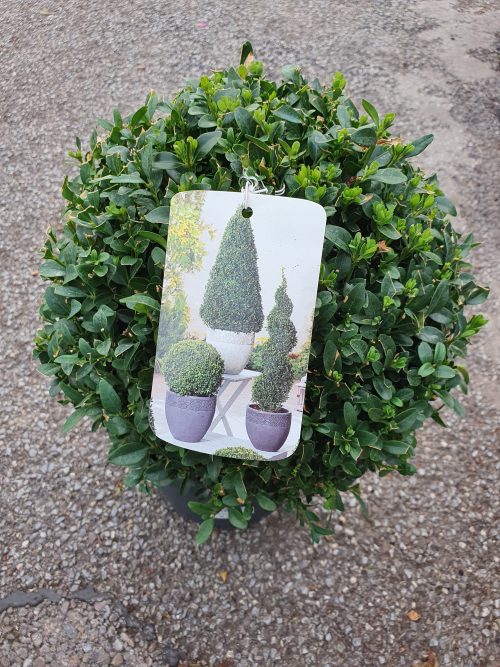
-
Out of stock
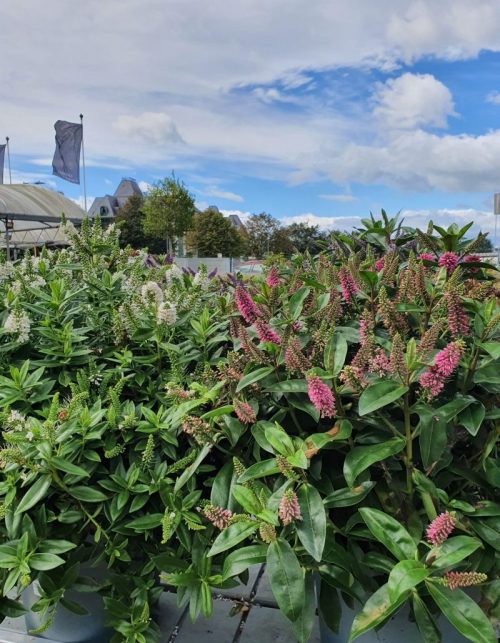 Hebe (Evergreen Veronica) is an easy to grow flowering evergreen shrub native to New Zealand and South America. Hebe plants come in many sizes ranging from dwarf shrubs, suitable for planting in patio pots and rockeries, to large hebe plants that are perfect for planting in a large garden. Many varieties of Hebe flower throughout summer and autumn - some varieties of Hebe flower during the winter. Although mostly hardy, a cold English winter can kill some types of Hebe plants. Hebes especially need to be protected from strong winds. The variegated-leafed Hebes seem to be amongst those most affected by cold winds and wintery weather. Hebes are easy to propagate from cuttings.
Hebe (Evergreen Veronica) is an easy to grow flowering evergreen shrub native to New Zealand and South America. Hebe plants come in many sizes ranging from dwarf shrubs, suitable for planting in patio pots and rockeries, to large hebe plants that are perfect for planting in a large garden. Many varieties of Hebe flower throughout summer and autumn - some varieties of Hebe flower during the winter. Although mostly hardy, a cold English winter can kill some types of Hebe plants. Hebes especially need to be protected from strong winds. The variegated-leafed Hebes seem to be amongst those most affected by cold winds and wintery weather. Hebes are easy to propagate from cuttings.FLOWERS ON A HEBE PLANT
The flowers on a Hebe shrub are small and grouped together in spikes. The colours of Hebe flowers range from white through pink, blue, lilac and purple to bright crimsons.
FOLIAGE
The leaves provide attractive year round foliage with different colours including silver and green, grey, violet, burgundy, bronze and red.BUTTERFLIES
This delightful shrub has flowers which will attract butterflies and bees to your garden.WHERE TO PLANT A HEBE SHRUB
A Hebe is a good all year round foliage plant. Its flowers can provide colour throughout all growing seasons. Grown in mixed plantings of summer annuals the flowers of a Hebe add to the floral display whilst the shape and form of the bush give a sense of stability. Hebe can be grown as an informal hedge - but if clipped back too hard it will not produce so many flowers. The smaller hebes make good ground cover plants or add interest to a rockery. A Hebe should be planted in a well drained soil and, if possible, in a position protected from wind.HOW TO PLANT A HEBE
- Before planting a Hebe soak the roots in water
- Dig a hole twice as wide as the container that the Hebe is in.
- Add a spadeful of compost and some general purpose fertiliser to the soil taken from the hole that you have dug.
- Remove the plant from the pot - tap the sides and base of the container to release the Hebe.
- Place the hebe plant into the hole.
- Fill in the space around the plant with the soil and compost mixture and gently firm with your fingers or tread in.
- Water in with plenty of water.
- Mulch around the base of the plant to help to conserve moisture.
-
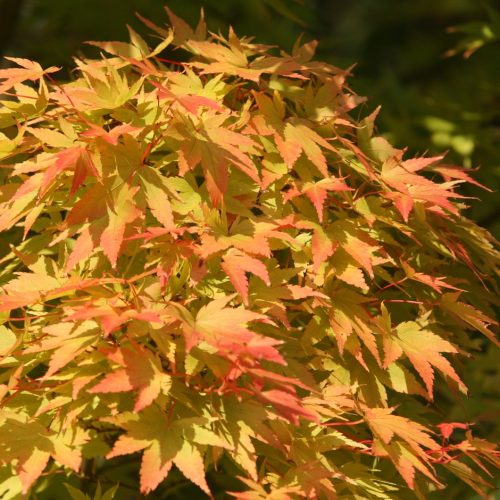 Acer 'Sangokaku' is a compact, bushy acer growing to.5m tall in 10 years. The leaves emerge green in spring, turning a ellow, orange before falling. Pot Size: 3L Plant Size • Mature Height: 5m • Mature Spread: 2m Why We Love It • Perfect as a spciment plant in cottage gardens, city gardens or for rock gardens an containers • Low maintenace What To Know • Season of Interest: Spring-Autumn • Position: Full sun, partial shade • Soil: Moist but well drained, organically rich How to Care • Pruning should be carried out in the dormant season (November to March) as Japanese Maples bleed during other times of the year, which can weaken the branches. • Water in summer if necessary. • Leaf colour is best in partial shade, although full sun can be tolerated. • Add a top-dressing of a well-balanced fertiliser around the base of a recently planted tree in late spring and keep it well watered. No routine pruning is required, just remove any dead, damaged or crossing branches in late autumn or winter when they are fully dormant.
Acer 'Sangokaku' is a compact, bushy acer growing to.5m tall in 10 years. The leaves emerge green in spring, turning a ellow, orange before falling. Pot Size: 3L Plant Size • Mature Height: 5m • Mature Spread: 2m Why We Love It • Perfect as a spciment plant in cottage gardens, city gardens or for rock gardens an containers • Low maintenace What To Know • Season of Interest: Spring-Autumn • Position: Full sun, partial shade • Soil: Moist but well drained, organically rich How to Care • Pruning should be carried out in the dormant season (November to March) as Japanese Maples bleed during other times of the year, which can weaken the branches. • Water in summer if necessary. • Leaf colour is best in partial shade, although full sun can be tolerated. • Add a top-dressing of a well-balanced fertiliser around the base of a recently planted tree in late spring and keep it well watered. No routine pruning is required, just remove any dead, damaged or crossing branches in late autumn or winter when they are fully dormant. -
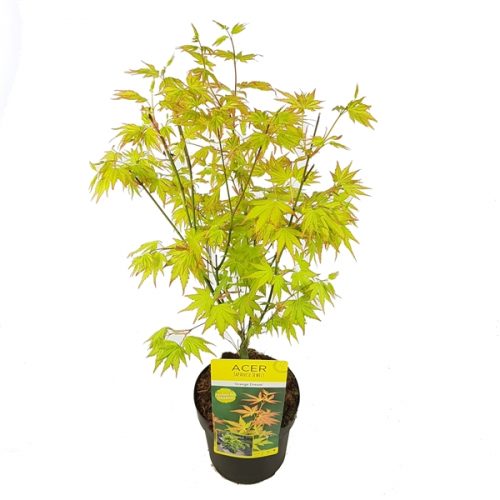
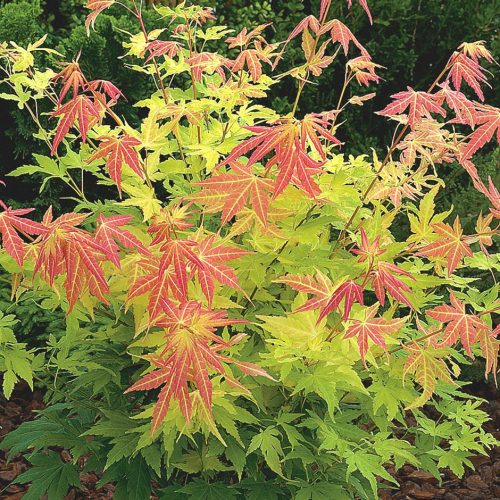 Orange Dream' is a medium sized bushy deciduous shrub, to 3m, with leaf colour varying at different seasons, yellow in spring, greenish in summer, orange-yellow in autumn. Bark is bright green. Redddish-purple flowers may be followed by red fruits Pot size: 3L Plant Size • Mature Height: 2.5-4 metres • Mature Spread: 2.5-4 metres Why We Love It • Perfect as a spciment plant in cottage gardens, city gardens or for rock gardens an containers • Low maintenace What To Know • Season of Interest: Spring-Autumn • Position: Full sun, partial shade • Soil: Moist but well drained, organically rich How to Care • Pruning should be carried out in the dormant season (November to March) as Japanese Maples bleed during other times of the year, which can weaken the branches. • Water in summer if necessary. • Leaf colour is best in partial shade, although full sun can be tolerated. • Add a top-dressing of a well-balanced fertiliser around the base of a recently planted tree in late spring and keep it well watered. No routine pruning is required, just remove any dead, damaged or crossing branches in late autumn or winter when they are fully dormant.
Orange Dream' is a medium sized bushy deciduous shrub, to 3m, with leaf colour varying at different seasons, yellow in spring, greenish in summer, orange-yellow in autumn. Bark is bright green. Redddish-purple flowers may be followed by red fruits Pot size: 3L Plant Size • Mature Height: 2.5-4 metres • Mature Spread: 2.5-4 metres Why We Love It • Perfect as a spciment plant in cottage gardens, city gardens or for rock gardens an containers • Low maintenace What To Know • Season of Interest: Spring-Autumn • Position: Full sun, partial shade • Soil: Moist but well drained, organically rich How to Care • Pruning should be carried out in the dormant season (November to March) as Japanese Maples bleed during other times of the year, which can weaken the branches. • Water in summer if necessary. • Leaf colour is best in partial shade, although full sun can be tolerated. • Add a top-dressing of a well-balanced fertiliser around the base of a recently planted tree in late spring and keep it well watered. No routine pruning is required, just remove any dead, damaged or crossing branches in late autumn or winter when they are fully dormant. -
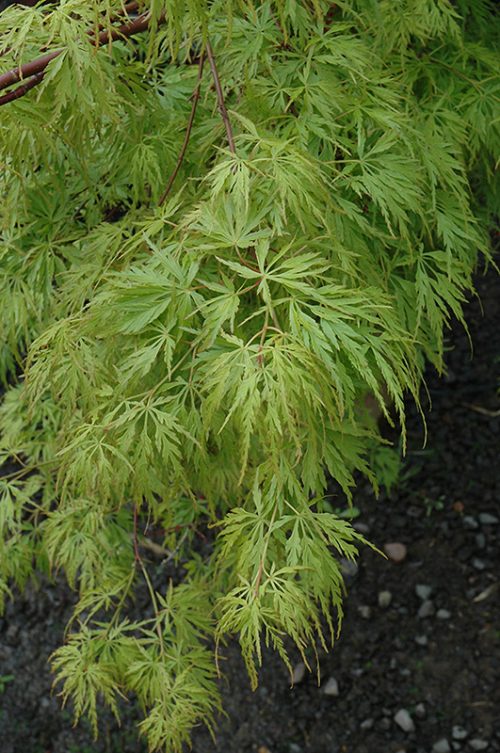 This lovely, green, dissected leafed Japanese Maple tree makes for a colourful splash in the garden. The lacy foliage is a bright, lime green throughout the spring and mid green in the summer, sometimes with a red tinge, before turning gold and red in the autumn. Acer palmatum dissectum 'Seiryu' is an unusual variety, as it is the only green dissected Japanese Maple tree with an upright growth habit, rather than the usual domed or weeping forms. Acer Seiryu has a striking vase shape which broadens slightly to a rounder form with age, eventually reaching a height and spread of 4 x 4 metres in 20 years. This dissected Acer tree is best positioned in a moist, well-drained soil in slight shade although it is tolerant of full sun. Acer palmatum 'Seiryu' makes a fantastic large shrub or small garden tree that offers an attractive, light canopy throughout the spring, summer and autumn. Pot size: 3L
This lovely, green, dissected leafed Japanese Maple tree makes for a colourful splash in the garden. The lacy foliage is a bright, lime green throughout the spring and mid green in the summer, sometimes with a red tinge, before turning gold and red in the autumn. Acer palmatum dissectum 'Seiryu' is an unusual variety, as it is the only green dissected Japanese Maple tree with an upright growth habit, rather than the usual domed or weeping forms. Acer Seiryu has a striking vase shape which broadens slightly to a rounder form with age, eventually reaching a height and spread of 4 x 4 metres in 20 years. This dissected Acer tree is best positioned in a moist, well-drained soil in slight shade although it is tolerant of full sun. Acer palmatum 'Seiryu' makes a fantastic large shrub or small garden tree that offers an attractive, light canopy throughout the spring, summer and autumn. Pot size: 3L -
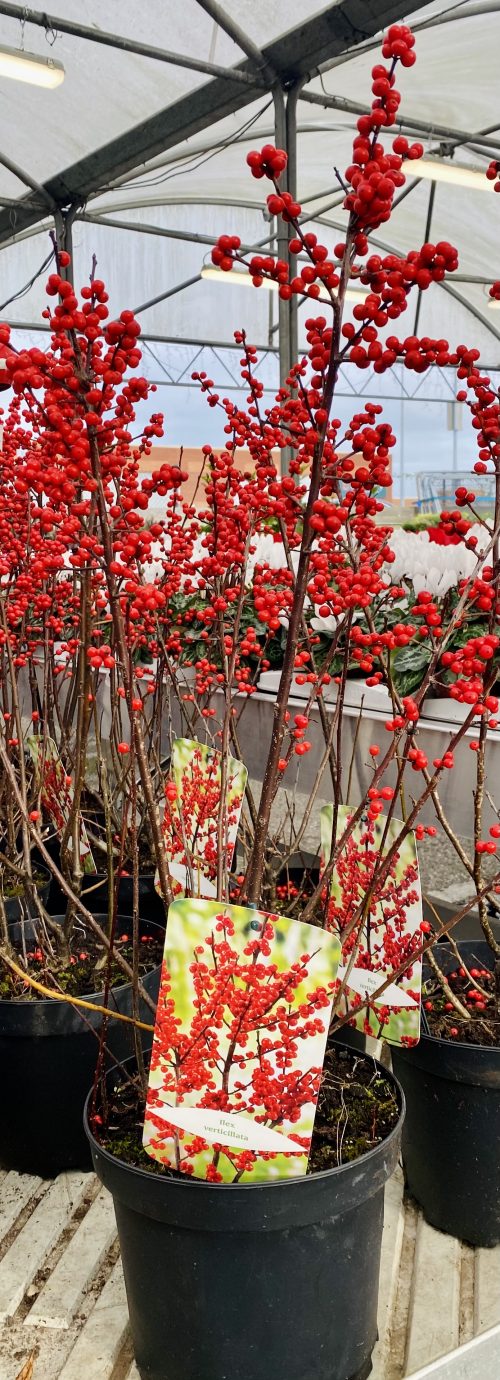 This Ilex Verticillata has magnificent red berries from autumn through to winter. It can be placed in full sun or semi shade. It is 200cm approx. and pruning is not recommended.
This Ilex Verticillata has magnificent red berries from autumn through to winter. It can be placed in full sun or semi shade. It is 200cm approx. and pruning is not recommended. -
Out of stock
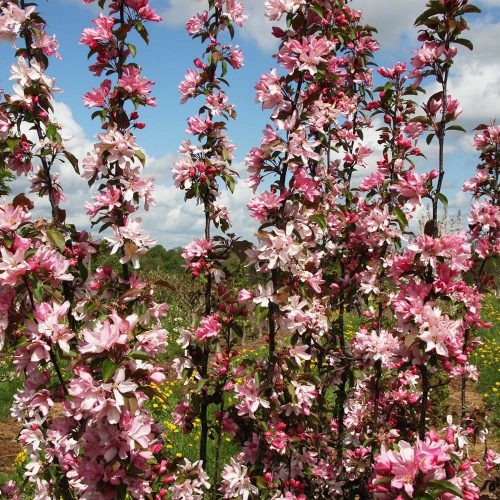
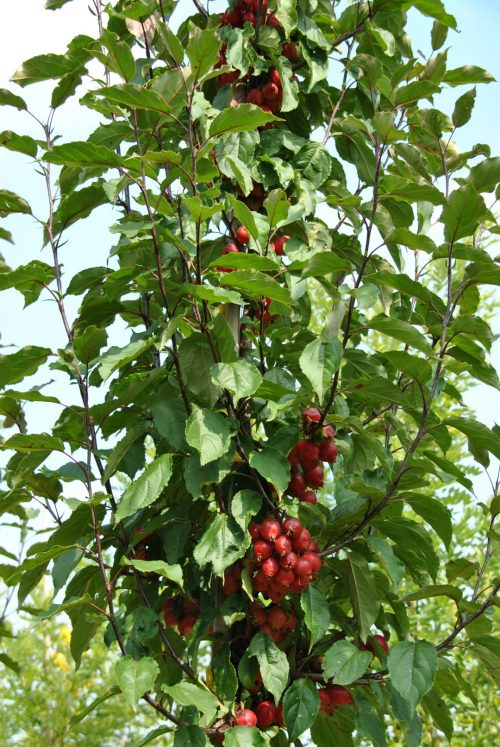 Malus 'Red Obelisk' Crab apple is a upright columnar tree that is perfect for small to medium sized gardens. Beautiful pinky white flowers in April & May with berries that follow in autumn. Plant Size • Mature Height: 3-4 metres • Mature Spread: 1-2 metres • Actual height 180-200cm • Pot size :10L Why We Love It • Fantastic amount of flowers in April and may. • massive amount of fruit in Autumn and winter. • bees land other wildlife love it. • Makes excellent jelly What To Know • Season of Interest: Spring, summer, autumn and winter interest • Position: Will do in sheltered or exposed sites. Likes full sun. • Soil: Moist but well drained, moderately fertile.
Malus 'Red Obelisk' Crab apple is a upright columnar tree that is perfect for small to medium sized gardens. Beautiful pinky white flowers in April & May with berries that follow in autumn. Plant Size • Mature Height: 3-4 metres • Mature Spread: 1-2 metres • Actual height 180-200cm • Pot size :10L Why We Love It • Fantastic amount of flowers in April and may. • massive amount of fruit in Autumn and winter. • bees land other wildlife love it. • Makes excellent jelly What To Know • Season of Interest: Spring, summer, autumn and winter interest • Position: Will do in sheltered or exposed sites. Likes full sun. • Soil: Moist but well drained, moderately fertile. -
Out of stock
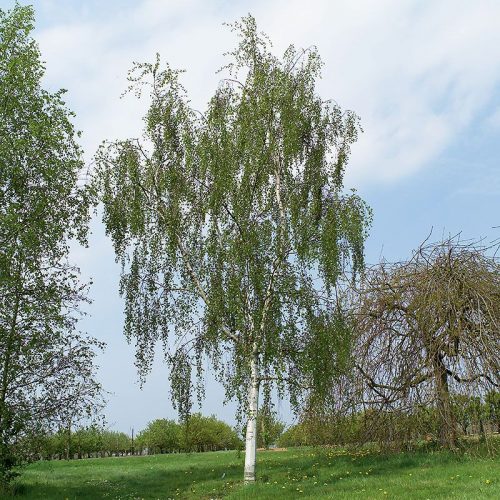 Betula Pendula Tristis is a tall and graceful tree with pendulous branches that are heavily weeping and twisted at the tips supporting a cloth of blue/green leaves. Catkins appear in the spring and the slightly serrated foliage turns creamy yellow in the autumn. This elegantly shaped birch tree casts a dappled shade and looks particularly attractive in the winter when its majestic form is fully revealed by bare branches. The beautiful, silvery smooth white bark provides year round interest and is a canvas to contrasting dark cracks and fissures that develop with age. Tristis is suited to most soil types and a 20 year height and spread of 7 x 4 metres can be expected. Pot size: 10L Height at the moment: 180cm-200cm
Betula Pendula Tristis is a tall and graceful tree with pendulous branches that are heavily weeping and twisted at the tips supporting a cloth of blue/green leaves. Catkins appear in the spring and the slightly serrated foliage turns creamy yellow in the autumn. This elegantly shaped birch tree casts a dappled shade and looks particularly attractive in the winter when its majestic form is fully revealed by bare branches. The beautiful, silvery smooth white bark provides year round interest and is a canvas to contrasting dark cracks and fissures that develop with age. Tristis is suited to most soil types and a 20 year height and spread of 7 x 4 metres can be expected. Pot size: 10L Height at the moment: 180cm-200cm -
Out of stock
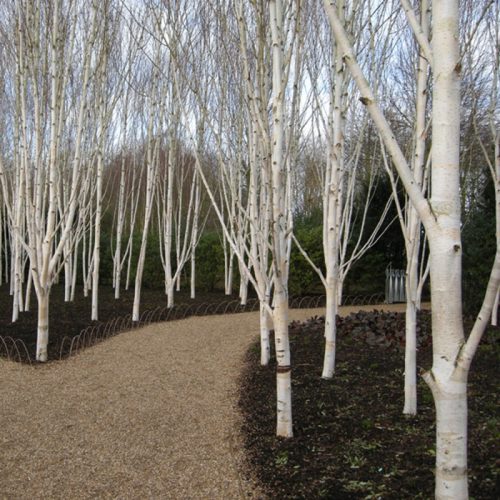 Betula Jacquemontii is a vigorous deciduous tree with brilliant white bark on the trunk and larger branches; ovate leaves turn yellow in autumn; yellow-brown male catkins open in early spring. CHARACTERISTICS:
Betula Jacquemontii is a vigorous deciduous tree with brilliant white bark on the trunk and larger branches; ovate leaves turn yellow in autumn; yellow-brown male catkins open in early spring. CHARACTERISTICS:- Soil: Moist, well-drained soil
- Max. Height & Spread: H-18 m or higher x S-10 m
- Season of Interest: Spring
- Position: Full Sun or Partial Shade
- Hardiness: Hardy
-
Out of stock
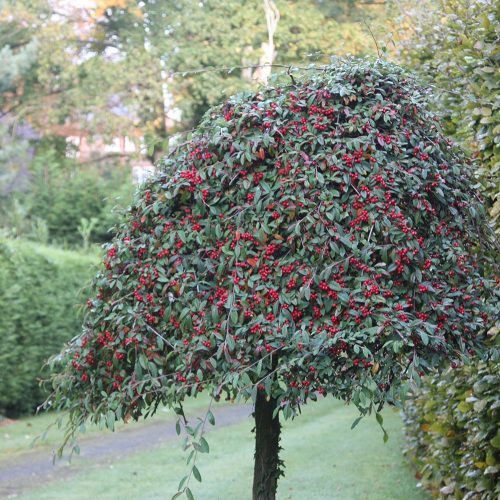
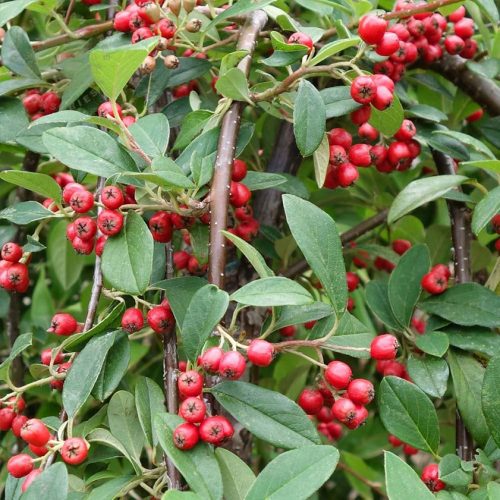 Cotoneaster Hybrida Pendula 'Hybridus Pendulus' is a vigorous prostrate evergreen shrub with large, elliptic leaves and small white flowers followed by profuse red berries in autumn; often top-grafted to form a pendulous small tree to 2m tall. CHARACTERISTICS: HARDINESS: Fully Hardy SOIL: moderately fertile, well-drained soil POSITION: Full Sun or Partial Shade FLOWERING PERIOD: June Fully Grown Height & Spread: 2m x 2m
Cotoneaster Hybrida Pendula 'Hybridus Pendulus' is a vigorous prostrate evergreen shrub with large, elliptic leaves and small white flowers followed by profuse red berries in autumn; often top-grafted to form a pendulous small tree to 2m tall. CHARACTERISTICS: HARDINESS: Fully Hardy SOIL: moderately fertile, well-drained soil POSITION: Full Sun or Partial Shade FLOWERING PERIOD: June Fully Grown Height & Spread: 2m x 2m -
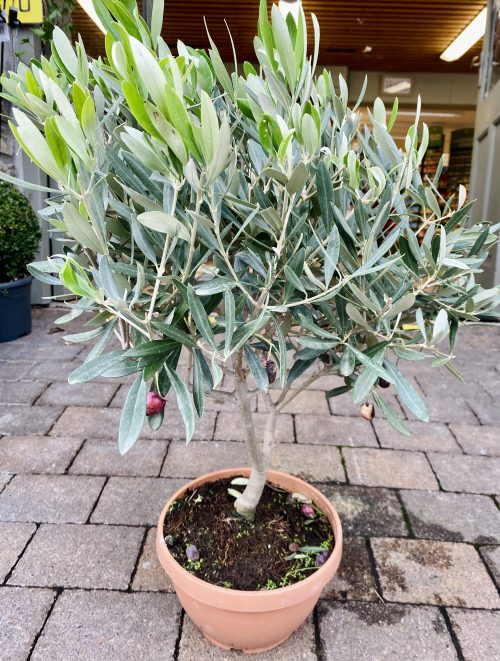 The Irish weather is perfect for growing Olive Trees as they can withstand the cold up to -15 degrees. They are slow growing and compact so they are ideal for small gardens or terraces and their evergreen grey-green foliage is a lift to any area.
The Irish weather is perfect for growing Olive Trees as they can withstand the cold up to -15 degrees. They are slow growing and compact so they are ideal for small gardens or terraces and their evergreen grey-green foliage is a lift to any area. -
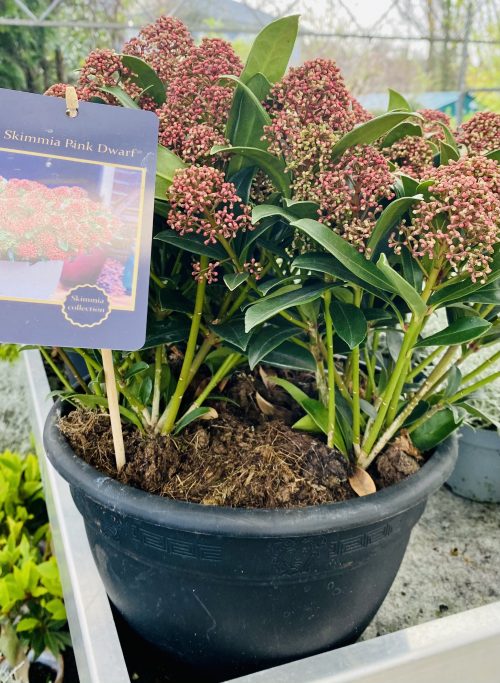 The Pink Dwarf is a compact growing Skimmia. Pink flower buds form in the autumn and and open to reveal pale pink flowers between March and May. Place in full sun/shade.
The Pink Dwarf is a compact growing Skimmia. Pink flower buds form in the autumn and and open to reveal pale pink flowers between March and May. Place in full sun/shade.